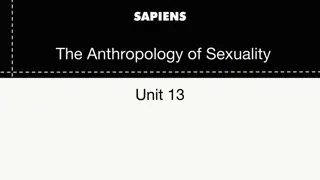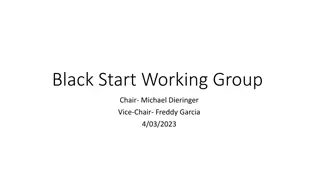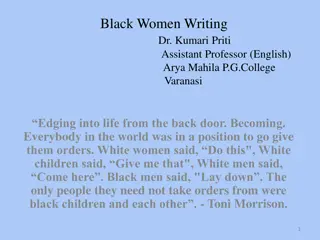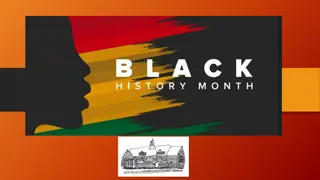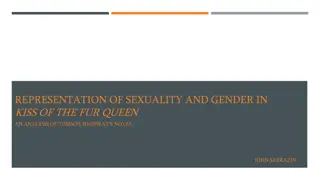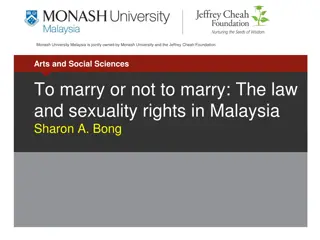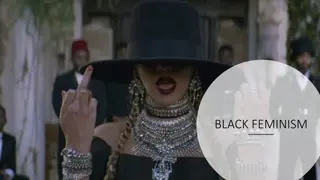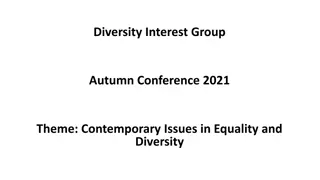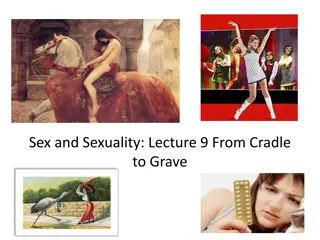Representation and Ideology of Black Female Sexuality
The history of Black feminist theory reflects the construction of black women as embodiments of sexuality, resistance to negative stereotypes, and the politics of silence. This iconography is evident in the portrayal of figures like the Hottentot Venus, revealing deep-rooted prejudices and the need for control over sexuality. The association of racial and sexual differences serves to perpetuate white male supremacy during colonial times.
Download Presentation

Please find below an Image/Link to download the presentation.
The content on the website is provided AS IS for your information and personal use only. It may not be sold, licensed, or shared on other websites without obtaining consent from the author.If you encounter any issues during the download, it is possible that the publisher has removed the file from their server.
You are allowed to download the files provided on this website for personal or commercial use, subject to the condition that they are used lawfully. All files are the property of their respective owners.
The content on the website is provided AS IS for your information and personal use only. It may not be sold, licensed, or shared on other websites without obtaining consent from the author.
E N D
Presentation Transcript
Week 3 Sander L. Gilman, Black Bodies, White Bodies: Toward an Iconography of Female Sexuality in Late Nineteenth-Century Art, Medicine, and Literature Anne McClintock, Massa and Maids: Power and Desire in the Imperial Metropolis
Representation Ideological, relying on stereotypes (conventions based on class, race, gender, ways of seeing that are invisible, unexamined and naturalized) Observers and producers of images both shaped by history Icons: representing a whole class/category; all visual representation uses icons
Three themes emerge in the history of Black feminist theory: 1. The construction of the black female as the embodiment of sex and the attendant invisibility of black women as unvoiced, unseen and everything that is not white. 2. The resistance of black women both to negative stereotypes of their sexuality and the material effects of those stereotypes on black women s lives. 3. The evolution of a culture of dissemblance and the politics of silence by black women on the issue of their sexuality.
Hottentot Female The Hottentot female most vividly represented in this iconography was Sarah Baartmann (before 1790 29 December 1815), known as the Hottentot Venus . Baartmann was crudely exhibited and objectified by European audiences and scientific experts. https://www.youtube.com/watch?v=r- 7bKi5MFWI
Hottentot Venus Icon of the Hottentot Venus/icon of the prostitute Essence of the black woman; absolute difference/sexualized woman; reduced to her sexual parts Evidence of racial difference (inferiority): as different from the European as the orangutan; sign of the primitive.
Black figures/prostitutes/primitives Source of pollution Illness of society/the diseased prostitute Children of alcoholics Concern with the prostitute s physical features (plump/fat; lazy); signs at the lower end of the scale of beauty Why was/is there such a negative construction of black women s sexuality?
To put it simply: Ideologically, these sciences reflected European males fear of difference in the period of colonialism and their consequent need to control and regulate the sexuality of those rendered other . Thus racial difference was linked to sexual difference to maintain white male supremacy during the period of slavery.
Discussion Questions Gilman 1. How did something that was initially adopted as a political strategy to maintain white male supremacy during the period of slavery become so ingrained in society as to be recognizable as a culture? 2. Can you think of any contemporary examples? 3. Or was it a result of an absence of detailed historical studies that little is known about the social constructions of sexuality changing over time alongside changing social conditions? 4. How can feminists dislodge the negative stereotyping of a black woman s sexuality and the attendant denials of citizenship and protection? 5. Has Jean Rhys contributed to this project in any way?
Imagery that is steeped in centuries of racism, oppression and misogyny
Anne McClintock, Massa and Maids: Power and Desire in the Imperial Metropolis Articulation of class, gender, race Gender: an articulated category, constructed through and by class (feminine women vs masculine women), just as gender is used as a regulatory discourse to manage class (working class women unrefined, not at home) Class and sexuality managed and policed by discourse on race Analogue between working-class women and black men; between prostitutes and blacks (dangerous criminality); between slum and colony
Discussion Questions 1. McClintock contends Munby equated female sexuality with servitude (80), is Anna s sexuality servile or does she demonstrate some agency? Walking bespoke leisure and male class power. (81) Analyse the figure of the Flaneur in Voyage in the Dark, what characters are seen to leisurely walk through the turmoil of the city? What does this tell us about their position within society? If the woman s body is the child s first space for knowledge and self-discovery, later the city, as the first space of modern self- knowledge, was mapped as a feminine space. Once feminized, the city was more easily represented and made docile for male knowledge and power, for such representations could depend on the prior fact of the social subordination of women. (82) Explore whether the city is a feminine space in Voyage in the Dark? 2. 3.
Discussion Questions 4. [G]ender is an articulated category, constructed through and by class. (94) How is Anna s gender articulated and constructed through her class? 4. Munby admired women who wore trousers but he was alone, most considered women in male attire as a threat to the moral fiber of the nation , absolutely unsexing the women and making them utterly coarse and unfeminine (117). Compare this to the way in which Rhys describes the importance of clothes in the novel?
Discussion Questions 7. In the last decades of nineteenth century, the urban crowd became a recurring fetish for ruling-class fears of social unrest and underclass militancy. Lurking in the resplendent metropolis, the crowd embodied a savage and dangerous underclass waiting to spring upon the propertied classes. As the embodiment of deviant agency, the crowd became the metonymic symbol of the unemployed and unruly poor; who were associated with criminals and the insane; who were in turn associated with women, particularly prostitutes and alcoholics; who were in turn associated with children; who were associated with primitives and the realm of the empire. The degenerate crowd [ ] violently irrational yet hypnotically ductile, savage and bestial, inherently criminal and, above all, female (119). Why is a masculine crowd feminized? Why is gender used as a regulatory discourse to manage class? Apply this to Anna, where is she positioned within the urban crowd ?



